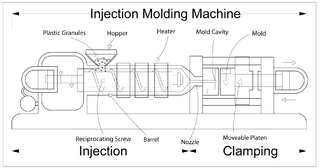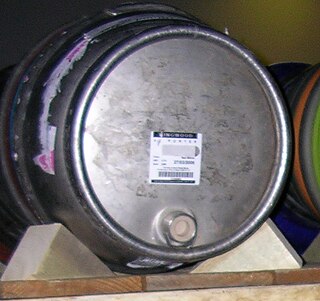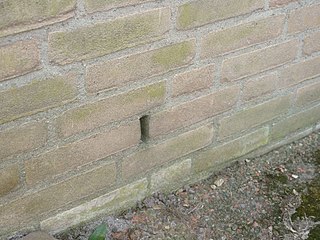This article needs additional citations for verification .(November 2009) (Learn how and when to remove this template message) |

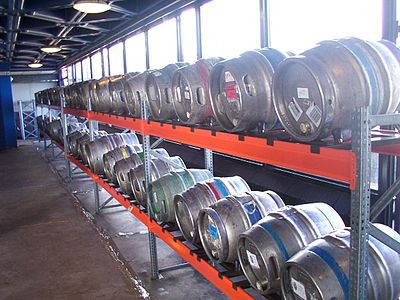
A shive is a wooden or plastic fitting used in ale casks. It is found on the curved side of the cask, arranged so that when the cask is on its side and the keystone is at the lowest part of the rim, the shive will be the highest point of the cask.

Wood is a porous and fibrous structural tissue found in the stems and roots of trees and other woody plants. It is an organic material, a natural composite of cellulose fibers that are strong in tension and embedded in a matrix of lignin that resists compression. Wood is sometimes defined as only the secondary xylem in the stems of trees, or it is defined more broadly to include the same type of tissue elsewhere such as in the roots of trees or shrubs. In a living tree it performs a support function, enabling woody plants to grow large or to stand up by themselves. It also conveys water and nutrients between the leaves, other growing tissues, and the roots. Wood may also refer to other plant materials with comparable properties, and to material engineered from wood, or wood chips or fiber.

Plastic is material consisting of any of a wide range of synthetic or semi-synthetic organic compounds that are malleable and so can be molded into solid objects.

Cask ale or cask-conditioned beer is unfiltered and unpasteurised beer which is conditioned and served from a cask without additional nitrogen or carbon dioxide pressure. Cask ale is also sometimes referred to as real ale in the United Kingdom, a term coined by the Campaign for Real Ale (CAMRA), often now extended to cover bottle-conditioned beer as well.
The hole in that part of the cask is used for two purposes. Firstly, it is used for cleaning out and then refilling the cask, which requires a large hole. Once the cask arrives at its destination, the hole is used to control the amount of carbon dioxide present in the container, which requires a small hole. The shive is effectively an adaptor that reconciles these conflicting requirements. It is a wooden disk, larger than a keystone, that fits in the hole in the cask and has a smaller hole in its centre.

Carbon dioxide is a colorless gas with a density about 60% higher than that of dry air. Carbon dioxide consists of a carbon atom covalently double bonded to two oxygen atoms. It occurs naturally in Earth's atmosphere as a trace gas. The current concentration is about 0.04% (410 ppm) by volume, having risen from pre-industrial levels of 280 ppm. Natural sources include volcanoes, hot springs and geysers, and it is freed from carbonate rocks by dissolution in water and acids. Because carbon dioxide is soluble in water, it occurs naturally in groundwater, rivers and lakes, ice caps, glaciers and seawater. It is present in deposits of petroleum and natural gas. Carbon dioxide is odorless at normally encountered concentrations. However, at high concentrations, it has a sharp and acidic odor.
For washing and filling, the old shive is removed using a chisel or a special tool, revealing a hole around 3 inches (7.5 cm) across. Once the cask has been filled and fined, a new shive is hammered into place. The hole in the centre of the shive will be sealed with a small wooden or plastic peg. The cask is then transported to the pub.
The inch is a unit of length in the (British) imperial and United States customary systems of measurement. It is equal to 1⁄36 yard or 1⁄12 of a foot. Derived from the Roman uncia ("twelfth"), the word inch is also sometimes used to translate similar units in other measurement systems, usually understood as deriving from the width of the human thumb. Standards for the exact length of an inch have varied in the past, but since the adoption of the international yard during the 1950s and 1960s it has been based on the metric system and defined as exactly 25.4 mm.

A centimetre or centimeter is a unit of length in the metric system, equal to one hundredth of a metre, centi being the SI prefix for a factor of 1/100. The centimetre was the base unit of length in the now deprecated centimetre–gram–second (CGS) system of units.

Finings are substances that are usually added at or near the completion of the processing of brewing wine, beer, and various nonalcoholic juice beverages. They are used to remove organic compounds, either to improve clarity or adjust flavor or aroma. The removed compounds may be sulfides, proteins, polyphenols, benzenoids, or copper ions. Unless they form a stable sediment in the final container, the spent finings are usually discarded from the beverage along with the target compounds that they capture.
Some time before the beer is to be served (two or three days is common; especially strong beers may require more) the cask is opened or "vented". This entails breaking the seal in the middle of the shive by punching it through into the cask with a mallet and some kind of tool, usually just a hard spile. A spile is then placed in the hole to regulate the gas flow. If the beer is particularly "lively" (common in warm weather and with specific beers) the contents may spray out when the cask is vented.

A mallet is a kind of hammer, often made of rubber or sometimes wood, that is smaller than a maul or beetle, and usually has a relatively large head. The term is descriptive of the overall size and proportions of the tool, and not the materials it may be made of, though most mallets have striking faces that are softer than steel.
A spile is a small wooden or metal peg used to control the flow of air into, and carbon dioxide out of, a cask of ale. Spiles can also be used to broach water from trees.
During use, the hole in the centre of the shive can also be used (with the spile removed) to insert a marked dipstick in order to measure the quantity of beer remaining.
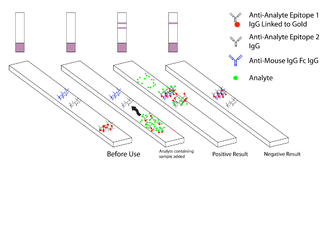
A dipstick is one of several measurement devices.
As with keystones, it is considered good form to close up the hole in the shive when returning empty casks, both to prevent spillage and to reduce bacterial and fungal contamination.


